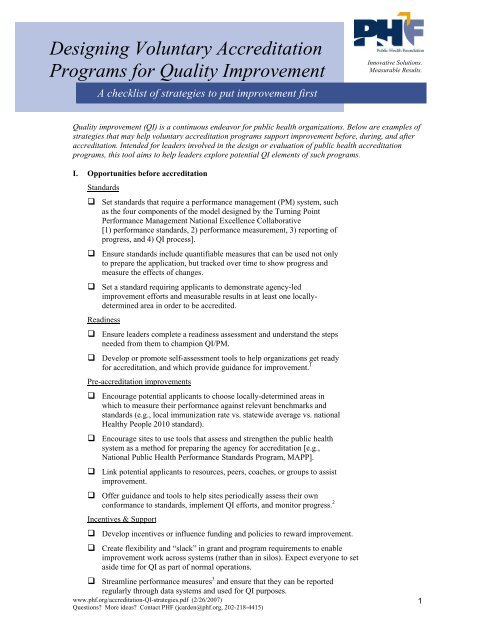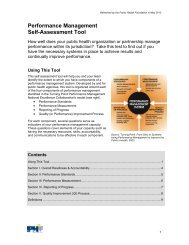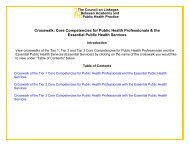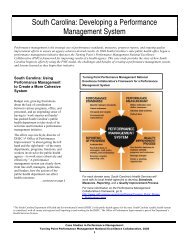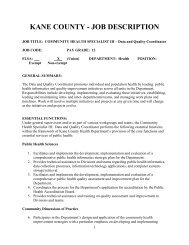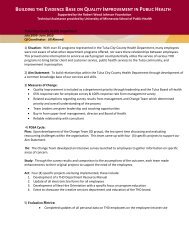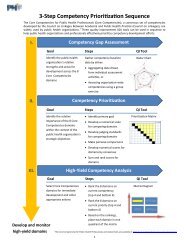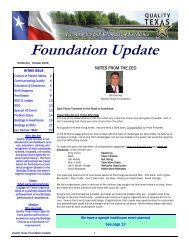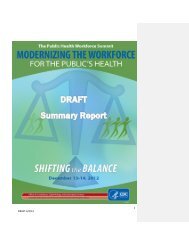Designing Voluntary Accreditation Programs for Quality Improvement
Designing Voluntary Accreditation Programs for Quality Improvement
Designing Voluntary Accreditation Programs for Quality Improvement
Create successful ePaper yourself
Turn your PDF publications into a flip-book with our unique Google optimized e-Paper software.
<strong>Designing</strong> <strong>Voluntary</strong> <strong>Accreditation</strong><br />
<strong>Programs</strong> <strong>for</strong> <strong>Quality</strong> <strong>Improvement</strong><br />
A checklist of strategies to put improvement first<br />
Innovative Solutions.<br />
Measurable Results.<br />
<strong>Quality</strong> improvement (QI) is a continuous endeavor <strong>for</strong> public health organizations. Below are examples of<br />
strategies that may help voluntary accreditation programs support improvement be<strong>for</strong>e, during, and after<br />
accreditation. Intended <strong>for</strong> leaders involved in the design or evaluation of public health accreditation<br />
programs, this tool aims to help leaders explore potential QI elements of such programs.<br />
I. Opportunities be<strong>for</strong>e accreditation<br />
Standards<br />
Set standards that require a per<strong>for</strong>mance management (PM) system, such<br />
as the four components of the model designed by the Turning Point<br />
Per<strong>for</strong>mance Management National Excellence Collaborative<br />
[1) per<strong>for</strong>mance standards, 2) per<strong>for</strong>mance measurement, 3) reporting of<br />
progress, and 4) QI process].<br />
Ensure standards include quantifiable measures that can be used not only<br />
to prepare the application, but tracked over time to show progress and<br />
measure the effects of changes.<br />
Set a standard requiring applicants to demonstrate agency-led<br />
improvement ef<strong>for</strong>ts and measurable results in at least one locallydetermined<br />
area in order to be accredited.<br />
Readiness<br />
Ensure leaders complete a readiness assessment and understand the steps<br />
needed from them to champion QI/PM.<br />
Develop or promote self-assessment tools to help organizations get ready<br />
<strong>for</strong> accreditation, and which provide guidance <strong>for</strong> improvement. 1<br />
Pre-accreditation improvements<br />
Encourage potential applicants to choose locally-determined areas in<br />
which to measure their per<strong>for</strong>mance against relevant benchmarks and<br />
standards (e.g., local immunization rate vs. statewide average vs. national<br />
Healthy People 2010 standard).<br />
Encourage sites to use tools that assess and strengthen the public health<br />
system as a method <strong>for</strong> preparing the agency <strong>for</strong> accreditation [e.g.,<br />
National Public Health Per<strong>for</strong>mance Standards Program, MAPP].<br />
Link potential applicants to resources, peers, coaches, or groups to assist<br />
improvement.<br />
Offer guidance and tools to help sites periodically assess their own<br />
con<strong>for</strong>mance to standards, implement QI ef<strong>for</strong>ts, and monitor progress. 2<br />
Incentives & Support<br />
Develop incentives or influence funding and policies to reward improvement.<br />
Create flexibility and “slack” in grant and program requirements to enable<br />
improvement work across systems (rather than in silos). Expect everyone to set<br />
aside time <strong>for</strong> QI as part of normal operations.<br />
Streamline per<strong>for</strong>mance measures 3 and ensure that they can be reported<br />
regularly through data systems and used <strong>for</strong> QI purposes.<br />
www.phf.org/accreditation-QI-strategies.pdf (2/26/2007)<br />
Questions? More ideas? Contact PHF (jcarden@phf.org, 202-218-4415)<br />
1
<strong>Designing</strong> <strong>Voluntary</strong> <strong>Accreditation</strong><br />
<strong>Programs</strong> <strong>for</strong> <strong>Quality</strong> <strong>Improvement</strong><br />
A checklist of strategies to put improvement first<br />
Innovative Solutions.<br />
Measurable Results.<br />
II. Opportunities during accreditation – site visit<br />
Shift the focus of site visits from solely con<strong>for</strong>mance (audits) to<br />
identifying improvement opportunities.<br />
• Make sites responsible <strong>for</strong> routine self-monitoring and quality audits<br />
to meet standards.<br />
• Verify improvement practices, processes, and the use of data <strong>for</strong> QI<br />
during the site visit.<br />
• If appropriate as part of a state site visit to local agencies, develop<br />
agreements specifying the responsibilities of each party to support<br />
improvement. 4<br />
Facilitate access to knowledgeable peers 5 and effective practices as part<br />
of site visits to spread innovation.<br />
Commend and celebrate improvement successes.<br />
Ensure staff are skilled or certified (e.g., ASQ certification) in auditing,<br />
QI, or QI consulting methods.<br />
III. Opportunities after accreditation – re-accreditation and support<br />
Ensure demonstration of agency-led improvement ef<strong>for</strong>ts and measurable<br />
results are a basis of re-accreditation. Compile and share applicants’<br />
storyboards, commendations, and effective practices. 6<br />
Enable accredited organizations to benchmark against a pool of<br />
accredited peers and relevant standards from public health or industry.<br />
Offer accredited organizations human and financial resources 7 to assist<br />
improvement.<br />
Offer guidance and tools to help sites periodically assess their own<br />
con<strong>for</strong>mance to standards, implement QI ef<strong>for</strong>ts, and monitor progress.<br />
Invest in research and evaluation related to QI.<br />
Engage accredited organizations in complementary QI initiatives, such as<br />
collaboratives, 8 and campaigns to spread improvement and innovation.<br />
Examples:<br />
1 See the self-assessment tools used in Michigan (http://www.accreditation.localhealth.net/Tools.htm, accessed 12/11/2006), North Carolina<br />
(http://www2.sph.unc.edu/nciph/accred/materials.htm, accessed 12/11/2006), and Washington State (Administrative Capacity Standards in<br />
Washington State Operational Guide and Self Assessment Tool).<br />
2 See the guidance offered by CDC’s National Public Health Per<strong>for</strong>mance Standards Program User Guide (2006 version) on how to organize staff <strong>for</strong><br />
improvements, set priorities, examine root causes of per<strong>for</strong>mance issues, develop action plans, and monitor progress,<br />
http://www.cdc.gov/od/ocphp/nphpsp/Documents/NPHPSPuserguide.pdf, pp. 25-39 (accessed 12/11/2006).<br />
3 See New Hampshire’s approach to streamlining measures, http://www.phf.org/infrastructure/PMexamples (accessed 12/11/2006).<br />
4 See Florida’s approach of developing agreements <strong>for</strong> improvement, noted at http://www.nnphi.org/onepagers.pdf, p. 4 (accessed 12/11/2006) and<br />
illustrated at http://www.phf.org/infrastructure/resources/PMCToolkit/FLQIDoc_MidLargeCounties.pdf (accessed 12/11/2006).<br />
5 See Florida’s use of peer reviewers described in the case study at http://www.phf.org/infrastructure/PMexamples (accessed 12/11/2006).<br />
6 See Washington State’s Exemplary Practices Compendium, http://www.doh.wa.gov/phip/PerfMgmt/stds/main.htm (accessed 12/12/2006).<br />
7 See North Carolina’s Public Health <strong>Improvement</strong> Fund, North Carolina Local Health Department <strong>Accreditation</strong>, http://www.nnphi.org/onepagers.pdf,<br />
p. 13 (accessed 12/11/2006).<br />
8 See the Institute <strong>for</strong> Healthcare <strong>Improvement</strong>’s Breakthrough Series Collaborative Model,<br />
http://www.ihi.org/IHI/Results/WhitePapers/TheBreakthroughSeriesIHIsCollaborativeModel<strong>for</strong>Achieving%20Breakthrough<strong>Improvement</strong>.htm<br />
(accessed 12/11/2006).<br />
www.phf.org/accreditation-QI-strategies.pdf (2/26/2007)<br />
Questions? More ideas? Contact PHF (jcarden@phf.org, 202-218-4415)<br />
2


